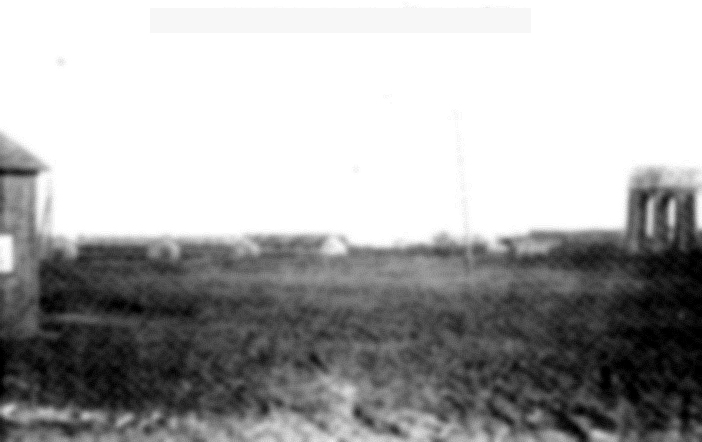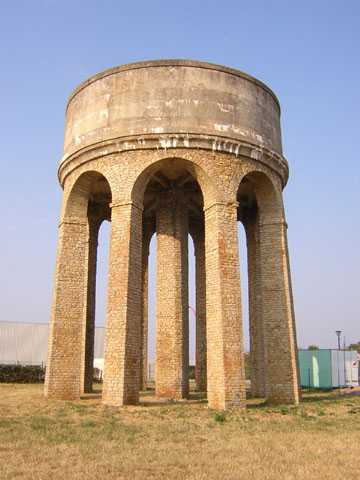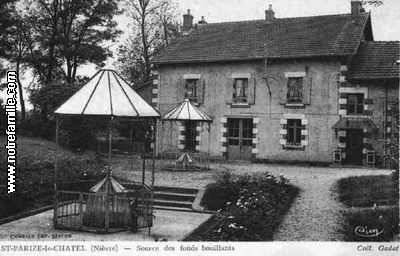 The laundrette
The laundrette
In Saint-Parize-1e-Chatel, it is below the church which one discovers the communal laundrette. It is crossed by the water of a generous source which supplies also a feeding trough towards which the cattle converged formerly.
The local inheritance of Saint-Parize-Le-Chatel
 The laundrette
The laundrette
In Saint-Parize-1e-Chatel,
it is below the church
which one discovers the communal laundrette. It is crossed by
the water of a generous source which supplies also a feeding trough
towards which the cattle converged formerly.
This laundrette is sheltered by a building built out of horseshoe.
Its frame is constant in an original way by four pillars out of wooden which take support on blocks of stone immersed. The ground is paved stones punts of Moiry.
This laundrette existed already more than one century ago, but the aspect which it offers in our eyes today, we must with the municipality in place in 1890, directed by the mayor, Mr. Robert, who decided to restore it. A stone of frontage testifies some. If, today, it seems to us an antiquated means to make the detergent, it represented, hundred years ago, a considerable progress, forming part of the elementary rural developments for health and the public health.
If it is hardly any more useful today, he is the one still recent time old witness where the life of the women was absorbed by heavy domestic tasks, like the weekly detergent. The lavender fields carried their linen on a wheelbarrow. It was necessary to work with knees. With this intention, they brought to the laundrette a kind of case to three sides with which the bottom was furnished with a cushion: the "cabasson". Household soap, brushes lasts, beater, the whole handled with heat made you a linen whiter than white. During the detergent, one told the news, the pewters circulated, the reputations was done, demolished oneself, from where the name "of hotel of the scandalmongering" allotted sometimes to the laundrette.
In the years 1960, the washing machine supplanted the laundrette and the boiler. However, there is with the borough, a faithful lavender field which is sulky its washing machine, to go, each Monday with the same pleasure, to make its detergent in running water. Other people will rinse the woollen articles there. They recognize with spring water of the incomparable virtues for wool. One also meets there, throughout the summer, the wagtail gray, called "lavender field" or "beater-detergent" because while going, it prints with its tail a movement of beater.
The municipality has care to maintain this witness last and St-Parizois are proud of their laundrette. Often, after the visit of the crypt, the walkers descend the hillock to this worthy place. The roof of their pleasure would be then to see a lavender field knelt at the edge of water. The stereotype would be thus perfect.
Vestiges of the
Gallo-Roman time
No vestige of the Roman
temple was found that the chroniclers announce to the place where Saint
Patrice founded his abbey, temple that the peasants, appointed under
the name of Bagaudes,
destroyed at the time of a rising to the �me century; but the region
preserved several traces of Roman civilization.
About 1840, one discovered in Villars of the ancient potteries, the Roman tiles and a paving stone into mosaic of the Lower Empire; there was, probably a rather important Gallo-Roman establishment
The sources of the
Ebullient Font were exploited
by the Romans. In his thesis, Doctor Arthur Galand reports
that SERTORIUS, Chef of a Roman legion, as well as a great number of
its soldiers having been reached leprosy were cured by mineral water
of Saint-Parize
Besides, the walls
which surrounded formerly the fountain and its paved hollow,
forming 3 distinct basins,
indicated its Roman origin.
One withdrew from
the source of the Virtues of the fragments of Roman potteries,
proof that it was exploited
at the same time.
Not far from there, in the Fair Fields, one found potteries and 3 swimming pools stages, connected between them by lead pipes.
In 1821, one collected in Saint-Parize a part of arsent 2nd century with the effigy of Sabine, woman of Adrien. The museum of Nevers has a large bronze of Marc-Aur�le (161-180) of m�ne source.
It is still with
the Wood of Edge, the discovery of a funerary well galloromain, close
to Suzeau,
a paved fountain
covered with flagstones in liking; in 1906, in Moiry, of 1672
parts of
currency and of various
objects. According to Antoine DESFORGES, 2 Roman ways crossed
the
territory of Saint-Parize-le-Ch�tel. The first, that
dAugustodunum (Autun) with Burdigala
(Bordeaux) by Avaricum (Bourges) passed in the fields of Gy, with the
fountain of the vertues then with Buy and from there moved on Sancoins.
The part which crossed the fields of Gy was destroyed of 1858 to 1881.
The second which left the fountain of the virtues directed towards
Nevers.
Monseigneur CROSNIER claims that the Romans had established uncamp cut
off in the fields from Gy. One found with the localities Vignot and the
Weak Vines, of the remainders of constructions, the tiles with edge,
the wells, of the hypogean ones, of the weapons and the coins.
 The American
Hospital
The American
Hospital
1915, the United States declares the war in Germany after
several British ships (of which Lusitania) were run by the German
fleet. American troops are dispatched in France.
Being not very far away from the face and close to the station
March-on-To combine, our commune will be retained for the construction
of a hospital. The first detachments arrive, they will be
followed by the medical profession and the military police
force. It is a true city which will leave ground during the
winter 1917-1918. Located on a triangle of 200 ha, for base
the trunk road and for having dimensioned, on the one hand the road of
Magny-Course in Saint-Parize and on the other hand that of Moiry with
Saint-Parize. Hundreds of brick hutments are born and it is a
population of 40 000 people which little by little will come to settle
there. All is envisaged, docks to store the goods, bakery, room of
spectacles, roads and railways allowing the routing of the
casualties. The water pumped in Combining it is channeled to
a tank, this one proving to be insufficient, the construction of a
water tower will be carried out. It will never be used
because on November 11, 1918, the armistice is signed and the American
troops set out again gradually. The cemetery which was with
the locality the Plain will be transferred in Nevers. A long
time the camp will be invaded by the vegetation, until the construction
of the agricultural college and the old circuit Jean Behra.
Today it remains for only vestiges the water tower and the
tank. A stele in remembering these combatants is on the edge
of the RN 7 between Moiry and Magny-Course.

LUSITANIA: British steamer torpedoed by a German submarine
close to the Irish coasts on May 7, 1915, 1200 passengers perished,
including 124 American.
 Theebullient
ones
Theebullient
ones
The hamlet of Font-Ebullient, located at the North-East and approximately one kilometer of the borough of Saint-Parize, draws his name from the gas mineral water fountains whose boiling is very apparent.
A legend wants that the mineral water initially was in Cougny. Certain harmful day an assassin washed there its glaive soiled blood. Water was moved. The genius appointed with their guard could not prevent the profanation, but it ordered to them to leave this place maudit. They rose in the airs. In their race they dropped some drops in the pond from Stretcher and the wood of the virtues, with the result that one sees boilings in these two places. A pioneer seeing them above his head, charmed them and reduced them in their current basin.
The source of Font-ebullient is exploited since a time
imm�morial.
The Romans installed a hydropathic establishment there
The amphitheatre was, says one, destroys by the warriors
of Charles Martel.
One believes that there was, towards XIle century, a maladrery which made give to the fountain the name characteristic of Well of Evils. In XVeme century the mineral water of the Ebullient Font was to have a certain reputation. It was analyzed, in 1789, by Hassenfratz.
The 15 niv�se year X, the Prefecture of Nievre d�boute
Fran�ois Tardy which asserted the source, and declare that the fountain
of Font-Ebullient, as well as thatch or neighbouring ground is well
really the property of the commune of Saint-Parize.
The fountain was repaired in 1854 and 1864.
Until 1894, this source remained communal property. One made
it exploit by a farmer who, in 1854, paid to a yearly rental of 50 F
the last contractor gave a ferrnage of 430 per annum F. Water cost 5
centimes the bottle to people of Saint-Parize; the foreigners paid it
10 centimes.
August 5, 1894 the alienation of the source was decided by the Town council. The sale was authorized by the Prefect on October 10. It took place on October 15.
Here besides an extract of the informal agreement intervened between the commune of Saint-Parize, represented by his mayor, Mr. George Stuffs, on the one hand, and Mr. Ferdinand-Charles G�lin, head of division to the Prefecture of Nievre, live Nevers, 8, Victor-Hugo boulevard, on the other hand.
"the commune sells with all the guarantees in fact and right:
l� the source of Font-Ebullient with the ground which surrounds it and the covered hangar, the whole 32 ares 40 centiares;
2� the ground containing the 2e source and which is only one part of old way, in front of the properties Grenut and Bordes, of the capacity of 30 centiares.
Conditions of sale:
L) The commune will be held with no repair. They
will be made by the purchaser and with his expenses.
The currently exploited source will be repaired, closed with lock and
covered by a roof in m�tal.La small currently unsuitable source with
any use, and which is opposite the first, will be also put
in good condition and will be covered, if it can be exploited.
2) Mr. C�lin will gracefully offer water at a rate of two liters per day and fire to the inhabitants of the commune, without distinction of position, those having the right to take at the same time water necessary to their consumption of several days. The water which would be required in addition of two liters per day and fire will be paid five centimes the liter.
3) If the medicinal virtues of the source can be recognized by the Academy of Medicine and that water is recognized of public utility, the inhabitants of the commune, on the production of a medical certificate, will have right to the free use of the baths and the showers.
Price: the payment of acquisition will be done in the following way -. Mr. G�lin, purchaser, will deliver with the commune a registered security of 400 F of revenue on the French State."
August 18 the 1896 sources became the property of a local company made up of 60 shareholders known as "Limited company of mineral Water of Saint-Parize-le-Chatel (Nievre), with the capital of 350 000 F entirely versed", then of another company which made ill-considered expenditure, then of Mr. Seigneurie, of Paris, finally in 1921, of Mr. Edmond Hervieux.
The source of Font-Ebullient is approved by the Academy of
Medicine and the Council of hygiene; it was authorized by the State by
decree of December 9, 1895.
The G�lin source, drilled and collected in 1895, is also authorized by
the State (decree of January 12, 1897) approved by the Academy of
Medicine and the Council of hygi�ne.Elle is prescribed against the red
gravel and the drop.
The doctors recommend it against the nervous diseases of the
stomach and of the intestine, against the dyspepsia and the an�mie.C'
is an excellent water of table.La G�lin source provides a water
medicamentous sulphated, calcic, very gas and ferruginous.
Its boiling, excessively abundant, is such as one can hear it with ten
meters of the establishment.
It is used to cure the gravel, the urinary diseases of tracts and the
bile ducts and, in ablutions, the cutaneous diseases.
One collects his gas surplus to reinforce the water of Font-Ebullient
in carbonic acid.
according to Antoine Desforges
(extracted the newspaper "nivernais It" of May 15, 1965)
ON The TABLE Of the ELYSIUM
All Nivernais know water of SaintParize which one finds on the table of many between-them. In a note September 2, 1865 on "natural mineral water of Saint-Parize-le-Ch�tel", one can read in connection with the source of the "Ebullient Font"
... It settled resolutely with the Elys�e palace where it
appears, tous.les.jours, on the table of the President
of the Republic (at the time Felix Faure), in the ministries,
prefectures and of large or the small restaurants of Paris where it is
very appreciated ".
Thus, the water of Saint-Parize has his letters of nobility
well. The source is at the exit of the agglomeration; each
year, more than two million water bottles leave there and this figure
has to only increase.
SOURCES AND THEIR PROPERTIES
Mr RICHON who took the direction of the Sources in 1953, following Mr DANJEAN and which is a also vice-president of the national federation of small and average mineral water owners, gives to this same newspaper the following information on water of Saint-Parize:
"How much T there - it has sources with Saint-Parize?
- There are three mineral springs: the source "Gelin', the
source" Elysium "and finally most important which is only exploited:
the source of the "Ebullient Font". It is necessary moreover
to announce the existence of a source of water of table: the source
"Ch�tel" that we go from here can put on sale.
- Which difference is there between a mineral water and a water of table?
- So that a water is sold under the name of water
mineral, one needs a ministerial authorization which is
given after opinion of the Academy of Medicine and the Higher Council
of Hygiene.
A water of table on the other hand needs only one prefectoral authorization to be put in trade. The essential condition is that it does not have more than 2 grams of mineralisation.
- Which are the properties of mineral water of Saint-Parize?
- By the calcium which it contains, it avoids decalcification and demineralization.
- By magnesium, it acts on the liver and moreover, it was recognized that this element is strongly anticancerigene.
Lastly, silica preserves hypertension and slows down arterial hardening.
- I believe that you will annex the manufacture of sodas to the exploitation of the sources?
- Yes indeed, the aerated beverages know a great vogue in this moment, that it is Evian or much of others, we see also multiplying the marks... why buy elsewhere what we same can have in Nievre "'.
This soda was actually marketed a few times later under the
SYMPATHETIC mark. Its slogan was,
SYMPATHETIC, the sympathetic nerve soda of Saint-Parize.
Commercial exploitation of the sources taken end definitively
in 1975.